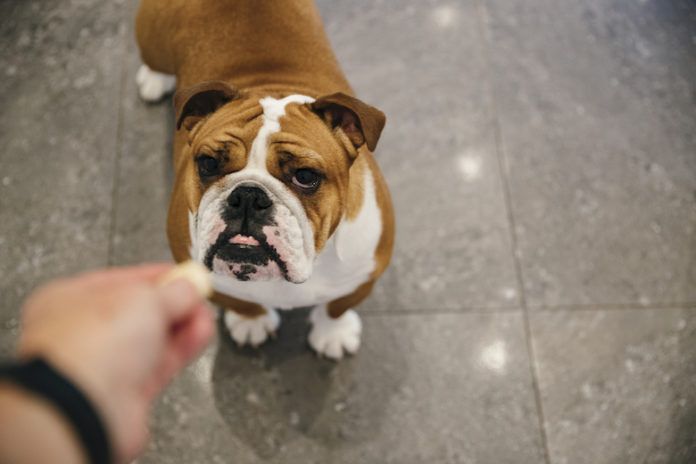With the ever-increasing popularity of force-free, positive reinforcement-based training, more people than ever are feeding their dogs treats, and that’s a very good thing. Hopefully you are one of them. But did you know there are right ways and wrong ways to feed treats to your canine pal?
The “right” way can vary, depending on your training goals in the moment, but most commonly involves feeding the treat directly to your dog’s mouth. Even this is not as simple as it sounds. Feed a little too high and you’re likely to lure the dog to get up instead of holding the position you’re reinforcing her for. Feed the treat a lot too high and you might encourage her to jump up and/or grab to get it. Feed a little too low and she may think you’re asking her to lie down. Feed too close and you’re invading her space – she may back away from you. Feed too far away, or pull back as she reaches for it, and you can teach her to get grabby for treats as she lunges to follow it. Ouch!
A good general rule of thumb is to offer the treat a half-inch to an inch away from the dog’s mouth, right at nose level, and keep your hand still as she takes it from your fingers. However, it’s important to remember that each dog is an individual, and you may want to experiment a little with your own dog to determine where the best treat-feeding spot is for her, while keeping in mind the above caveats.
There are also times when you might choose to feed treats somewhere other than directly to the mouth. If you are working on attention, you can toss the treat on the ground to get your dog to look away from you, then invite her attention back with her name or a “Look!” cue, mark with a clicker or verbal marker when she looks, and feed the next treat by tossing it on the ground so you can cue the “Look” again. If you’re shaping a “go to mat” behavior, it’s helpful to toss the treat behind her after you click her for moving toward the mat so she “resets” and can move toward the mat again. And if you have a dog who is very sharky about taking treats (i.e. – leaves your fingers shredded) you can toss the treat on the ground just to save yourself from pain and bloody lacerations, until you teach her to take treats gently. Another finger-saving technique is to feed the treat from the palm of your hand as you would feed a treat to a horse. Alternatively, you can feed sticky treats (cheese, peanut butter) from the end of a wooden spoon to save your fingers, or make a soft dog food mush that you can squeeze from the ending of a dog training squeeze tube. (https://www.petexpertise.com/dog-training-food-tube/)
And yes, it is possible to teach your canine shark to take treats gently. I do not recommend the oft-repeated advice to “yelp like a dog” when your dog bites too hard. We aren’t dogs, and we never really know what we’re communicating when we try to pretend that we are. Plus, in my experience, a significant number of dogs just get more aroused when you start yelping. Instead, offer your dog a low-value treat in a closed fist, grit your teeth while she gnaws at your knuckles, and when her mouth finally softens a little, open your fist and feed the treat from the palm of your hand. (You can wear gloves for this, if necessary, to reduce wear-and-tear on your skin.) You can add a “gentle” or “easy” cue as you offer your close fist, and then use this cue as a reminder once she has learned to be soft, if you feel her reverting to taking treats with a hard mouth.
If you must say something, try a soft, calm “Ouch” to let your dog know she is hurting you. Over time and many repetitions, gradually wait for her mouth to get softer and softer before opening your fist, until she can routinely take even high-value treats appropriately. Be aware, though, that your reformed shark is very likely to revert to taking treats hard when stressed or excited, and even a soft-mouthed dog can give your fingers a resounding pinch when aroused! With time and practice, however, you and your dog can share a lifetime of appropriate treat delivery and soft-mouthed treat-taking.
Featured photo: SolStock/Getty Images
Read Next: How to Choose Top-Quality Dog Treats for Your Dog







Hi there whe I was little kid my dad has a few horses and cows and I have to ride my horse every day it was so fun…
Now I know that feeding treats for dogs having its own rules! Thanks! I’ve learned a bunch of things!
I love this article and the understanding that the owner/handler has to be trained first. Our dogs take treats out of my hand very gently…but when it comes to my wife and kids, they lunge and nip. I’m hoping that having them read your article will help them to understand that the behavior of the handler happens first – the behavior of the dog follows.
A decline in your dog’s sight can result in “ouches”, She wants the treat but may not be able to properly judge distance and chomp a bit more than usual. This is time to feed a treat in an open palm.
O.K., I am beginning to feel like this forum is the social justice warriors of dogs. You are talking about having pain and bloody lacerations from feeding a dog treats? Sorry, do NOT buy that. I have a 6 lb. Yorkie and I would NEVER allow her to bloody my fingers for a freakin treat. Nor do I allow her to bark her Tasmanian Devil head off at me. And yes, I yell at her, I jerk her away from something bad she is doing and I put her in the bathroom and close the door when she goes nuts. When she acts like a spoiled child, she gets treated like one. Sometimes bad behavior just needs to be punished.
Susan: Nothing like dominating a Yorkie to make feel you won the battle. How about patient training instead of yanking and yelling? Try to imagine you are at the other end of the leash or locked in the bathroom. Ruling by fear isn’t ruling at all and no wonder she barks in complaint at you. My Havanese was a barker but ignoring him when he barked, leaving the room, etc. and then rewarding him when he stopped on command worked over time and he wasn’t a puppy so perhaps it’s you who needs some training? Good Luck!
First off I would like to say superb blog! I had a quick question in which I’d like to ask if you do not mind.
I was interested to know how you center yourself and clear your mind before writing.
I have had a hard time clearing my thoughts in getting my ideas out.
I do take pleasure in writing but it just seems like the
first 10 to 15 minutes are usually wasted just trying to figure out how to begin. Any recommendations or tips?
Cheers!
I have five dogs, three rescues and two brothers born from one of my rescues. When I announce treat time, they all gather around and sit without any command. When I hand out the treats, I say each dogs name and then hand him or her the treat. Four of them gently take the treat from my hand. However, one of the brothers tends to be a bit more aggressive when I give a treat to him, nipping my fingers as he grabs it. I solved the problem by making him wait until last for his treat, and when it’s his turn, I remind him to be “gentle” before I hand it to him. As long as I remind him each time, he takes his treat as politely as the others.
I’m getting a new puppy in December and it’s been 16 years since I had one. My boxer was “the best” (aren’t they all tho?? 🙂 but I remember her antics as a puppy, and she was a jerk, to put it bluntly. She chewed inappropriately- got herself into all sorts of things. Her problem was she was too smart, lol… if the smart dogs get themselves into trouble like that, I’ll gladly take the “C” student any day…but I digress.
I kept her on a leash in the house and her “punishment” was she had to sit/ hang out with me….. wiggly puppies hate that..lol.
One of the more painful training lessons I had to endure was teaching her not to nip legs while walking. The fist feeding method mentioned in the article reminded me very much about that time, and when I sacrificed my calves for the greater good.
If she started nipping legs while I walked, I would immediately stop and stand completely still. I took those puppy needles to the calves and just did slow breathing until she figured out she wouldn’t get a reaction from me. When she backed off and looked puzzled, I would commence walking. If she went and lunged for me, then we’d repeat until she quit and realized the lesson of “biting legs = no fun”. Luckily she was a smart girl and picked up on this stuff rather quickly. I like the whole concept of “undesirable behavior makes people not want to play with you and good stuff go away” and actually I found some of these theories cross over to child rearing…lol. My challenge with a new puppy now is having two boys (6 and 11) that I need to teach these concepts to. I’m getting a cane Corso, so it’s not going to be a little guy- and I want to make sure the dog listens to and respects the kids also…. so I’m puppy training x3 this time around. Wish me luck
I would luv to see a grass roots effort by you and other veterinarians to get the vet colleges to teach more about understanding dog behavior and also impart a much larger knowledge on diet and foods that are better for our dogs . Prevention is a form of wellness. Your knowledge Dr. Miller in so many areas that most vets don’t have is so helpful and needed. Why is Cushings Disease so common , why do both my dogs have pituitary driven Cushings and they are different ages and breeds? No one seems to know. I propose it is environmental and dog food causal….
Not to mention breeding deterioration. It’s sickening how much illness is out there and so little research for dogs. My vet bills are staggering with Cushings.
Thankyou for caring to have the knowledge
YMMDthe breakup movieIt’s easy to downplay country music as “always happy and sad” or “cheesy.” But, country music is a genre that celebrates the good times and the bad times. From the upbeat, cheerful “Always” to the heart-wrenching stories of a broken relationship, country music has a wide variety of songs to help listeners cope with a breakup. Cody Wolfe sings great songs and I love his song better without you. He is so amazing